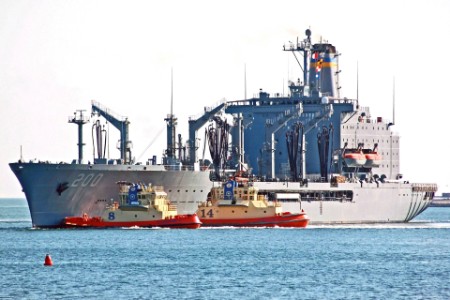Fleet commanders do not have the visibility they need into the US Navy supply chain for munitions, food and other essential classes of supply. This lack of visibility creates a critical readiness gap and ultimately prevents commanders from making agile decisions with knowledge of the end-to-end supply chain.
As geopolitical and cybersecurity threats mount, Navy leaders need supply chain processes and information to operate with speed and scale. Currently, supply chain information is isolated in individual, stove-piped systems across ships, suppliers and fleet supply depots. As a result, nobody in this network has the complete, end-to-end view of critical logistics information to answer basic questions: How much do we have? Where is it? And when can we get it?
Data isolation prevents broader network analysis to create actionable information, insights and predictions about supply flow and bottlenecks. An enterprise-level approach is foundational to securely manage data and analytics for end-to-end supply chain visibility that supports warfighting in a contested logistics setting. Without end-to-end visibility to the supply chain, risk rapidly expands. With time, as adversary capabilities advance, battles could be lost.
The Navy needs two main things now to achieve the supply chain performance necessary to win in contested logistics scenarios: resiliency and culture change.
How the Navy can achieve greater end-to-end supply chain resiliency
Resiliency, in a Navy supply chain decision-making context, means having the agility and visibility to plan for scenarios and then mitigate challenges in real time, resulting in better decisions.
To achieve this resiliency, leaders must have access to real-time data with visibility of current supply chain performance to understand and anticipate developing problems and bottlenecks. The challenge for the Navy is that many entities own individual parts of the supply chain, and there is no central command and control function that identifies and communicates end-to-end supply and demand needs. After a mission is executed, leaders often are forced to wait for correct, up-to-date information due to the lack of real-time supply and logistics data. These frustrating delays can have serious military consequences.
However, delays can be reduced significantly by having a better understanding of the data that the Navy already owns. If the data is appropriately integrated, demand and supply scenarios can model critical risks and enable proactive action. Leaders can gain insights into potential disruptions before they even occur. The Navy should start this journey of supply chain transformation by implementing modern supply chain technologies with advanced analytics capabilities, such as a control tower and digital twins, and create the visibility that fleet commanders require. This is crucial given the likelihood of an increasingly contested operating environment for the Navy, making it urgent to move quickly.
Moving beyond manual process with a supply chain control tower
Today, visibility is created manually by fusing information from different sources into spreadsheets and slide decks, which is reactive and outdated by the time the commander is briefed. Instead, the Navy supply chain control tower could capture and use real-time operational data across the supply chain ecosystem to provide enhanced visibility and improve decision-making.
The supply chain control tower would also provide a secure data gateway to transfer on-premises data sources to cloud-based storage and perform data transformation. To improve the Navy’s supply chain operations, it’s essential to understand the available existing data, transition offline data sources to widely visible information repositories, and automate tasks to reduce the manual effort of high-impact tasks.

